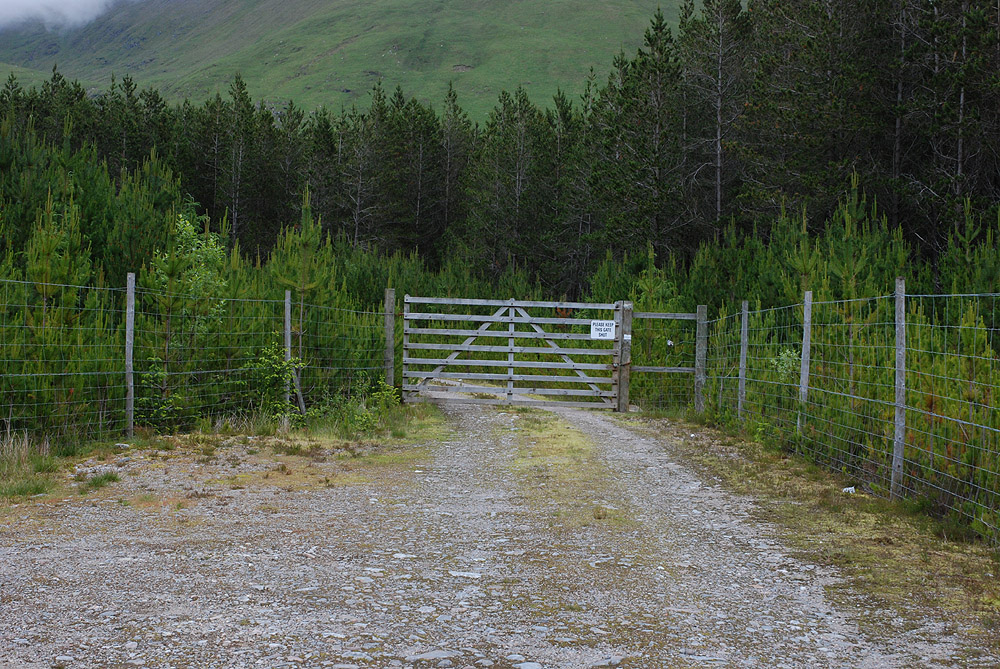Landholders have allegedly blocked or deterred public access to Scotland’s paths more than 1,000 times in recent years according to data logged by local authorities.
Issues included security guards deterring access to a peninsula, £800 worth of council signs being stolen and replaced with “Private Land” signs, a fence barring access to a Corbett summit, and a sea passage between two islands being blocked.
Obstructions and other issues were reported at nearly 100 estates across the country. In one case, girl guides were reportedly denied access to an estate and kayakers were wrongly told to pay to access an estate’s loch.
There were also complaints about the MOD shutting routes, housing developers closing, obstructing, or damaging paths during construction, and of planning conditions being breached when replacement routes were not built.
Scotland’s land reform act sets out a right of responsible, non-motorised access to land and inland water, with a few exceptions, such as residential gardens.
The Ferret used freedom of information law to obtain a list of the 1,978 access issues recorded by 21 local authorities and two national park authorities between April 2017 and February 2022. The entire list is available to our members.
Eleven councils, including large rural ones like Aberdeenshire and Highland – the latter of which makes up a third of Scotland’s land – did not provide any data, meaning the true figure is likely to be much higher.
The problems were reported to local and park authorities by the public, landowners and others, or logged by local authority staff. Walking and access groups argued the figures reflected councils’ “years of chronic underfunding” of access officer roles, which uphold access rights.
More than half of the reported issues related to paths being reportedly obstructed by landowners, occupiers and others, including electric, barbed wire and other fences, locked gates, no entry signs and the public being told to leave.

Ramblers Scotland said it was “truly shocking” to see “the deluge” of reported obstructions nearly 20 years after the Scottish land reform act introduced rights of responsible public access. Landowners must be ”urgently reminded” of their responsibilities, the group argued.
Scottish Land & Estates, which represents landowners, said the issues were mostly minor, “easily resolved”, did not breach access regulations and involved “all types of landowner”.
Access issues at estates represented “less than five per cent of the total”, they highlighted, with the majority apparently occurring on local authority controlled land.
| Location | First reported | Issue |
|---|---|---|
| Culbin, Moray | 2021 | MOD closed paths for military drills. Agreement that MOD must ensure public safety but not block public access rights |
| Dunira Estate, Comrie, Perthshire | 5/10/2017 | Estate allegedly told Girl Guides “they can't take responsible access”. |
| Ferry Inn, Rosneath, Argyll | 21/03/2018 | Fencing across foreshore and "aggressive behaviour". Police were involved. |
| Over Benchil, Perthshire | 01/05/2019 | Electric fence and locked gates on core path. Obstructions removed but reinstated alongside barbed wire and chains. |
| Castle Toward, Argyll | 7/12/2018 | Landowner did not comply with planning conditions to build a path to "mitigate loss of access rights". |
| Ardeer Peninsula, North Ayrshire | 06/01/2020 | Fences restricting access to peninsula. Security guards told public to leave. Leaflets and signs discouraging access. |
| Airds Bay, Ardchattan & Muckairn, Argyll | 12/03/2020 | Sign erected saying "Your dog could be shot if found amongst livestock". |
| Preston Glen, near Linlithgow, West Lothian | April 2020 | Council logged 33 complaints about obstructive fencing, CCTV and “inappropriate signage”. |
| Blackburn, West Lothian | June 2020 | Council signposts removed and replaced with “Private Land” signs. Council “reported £800 of theft to the police”. |
| Linn Mill, South Queensferry, Edinburgh | July 2020 | Two reports of “broken, dangerous steps going up to the canal”. One claimed to have “witnessed a near miss”. |
| Path to Corbet, Auch Estate, Argyll | 10/10/2020 | Deer fence barring access to Beinn Bhreac-liath summit from the north. |
| Kingussie, Cairngorms National Park | 12/10/2020 | Footpath allegedly “not reinstated as per planning approval when four houses were built”. |
| Beecraigs Country Park, West Lothian | December 2020 | Complaints from cyclists of logs placed across Cockleroy paths, "some at head height to cause injury". |
| Cumberland Avenue, Helensburgh, Argyll | 5/13/2007 | Council logged 33 complaints about a fence blocking woodland access. |
| Torsa and Luing, Argyll | 9/23/2021 | Landowner raised causeway, preventing sea paddlers from passing between the isles. |
Other access issues

Some 275 issues related to access inquiries, where the public or landholder asked local authorities which access rights applied to certain areas, including whether they could be revoked.
In 196 cases local authority access logs stated or implied that a path had not been maintained, usually by the local authority or landholder responsible. In some cases the public alleged that paths had become dangerous or impassable.
Dumfries and Galloway Council received regular complaints about paths being obstructed by overgrown vegetation across the region, but due to budget constraints, decided to not cut back overhanging plants and trees.
These included paths in and around Annan, Beattock, Castle Douglas, Criffel, Dumfries, Gretna, Isle of Whithorn, Kippford, Kirkcudbright, Lockerbie and Rockcliffe.
“As maintenance is not a statutory function, funding for this type of work is often very difficult to find and often other council functions, which are statutory duties, will take priority,” a spokesperson told The Ferret.
Funding shortages have “a knock on effect to the quality of the core paths, with some becoming inaccessible during the summer months when the vegetation can restrict access,” they added.
“This is understandably frustrating for both ourselves and users, but we believe this is a common issue throughout local authorities in Scotland.”
Seventy reported issues related to paths being obstructed by natural causes, like fallen trees, landslips and flooding.
Another 89 involved allegedly irresponsible access from the public, who caused problems like vandalism, anti-social behaviour, damaging property, fly-tipping, littering, letting dogs chase livestock and wildlife, not picking up dog poo, or leaving gates open in farmers’ fields.

Some 59 per cent of the reported issues were marked as resolved and 29 per cent had not been fully resolved at the time of our request. In 12 per cent of cases, the local authority did not state, or was not aware of a resolution.
Richard Barron, of the Scottish Rights of Way & Access Society, said: “Disappointingly the results also show the effect of not putting adequate resources into managing outdoor access. I wonder how many of the unresolved issues would have been dealt with if this were not the case?“
The Ferret’s study was “a fascinating insight into the work of access authorities in protecting the right of responsible outdoor access in Scotland and given the number of people accessing the outdoors, it is not as bad as it could be,” he claimed.
Ramblers Scotland director Brendan Paddy said that the wide-ranging and often serious reports could “affect the entire outdoors community”.
“While Ramblers Scotland will continue to work strenuously to engage walkers to ensure they take their responsibilities seriously, these new figures suggest that it is time for landowners to also be urgently reminded of theirs,” Paddy added.
Stephen Young, head of policy for Scottish Land & Estates said: “Access rights have been enshrined in law since 2003 and our organisation and members were heavily involved in the creation of the Scottish Outdoor Access Code, which is widely regarded by government and rural organisations to have worked well.”
He added: “The overwhelming majority of estates across Scotland are not only happy to encourage access but also know that visitors enjoy the wide range of facilities and activities that are provided by estates.”
Header image credit: Ivan Radic















The Scottish Government are quietly running a consultation exercise about revisions to the Land Reform Act. The consultation runs until the 25th of September.
https://consult.gov.scot/agriculture-and-rural-economy/land-reform-net-zero-scotland/consultation/
It’s mostly about land ownership and subsidy, but questions 28 and 44 are pretty open ended. I would have thought that “Landowners in receipt of any public subsidy must be able to demonstrate compliance with the Scottish Access Code.” would be a fairly clear public statement.